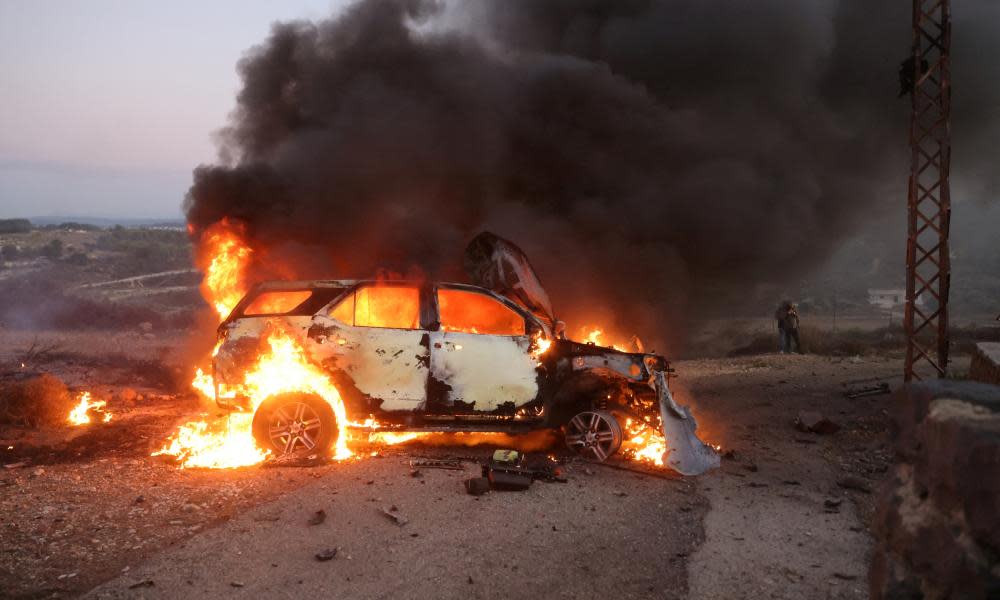Israeli airstrikes hit northern Gaza as Palestinians try to leave

Thousands of Palestinians have continued to leave northern Gaza and cram into already crowded schools, homes and makeshift shelters in the south, as Israeli airstrikes pound the blockaded strip ahead of an expected ground invasion.
Foreign citizens may be allowed to leave the enclave on Saturday, under a deal agreed by Egypt, Israel and the United States, senior Egyptian and US officials said.
Around 2.3 million Palestinians are trapped in Gaza, facing a terrifying escalation of bloodshed and misery, after Israel sealed all crossings into its territory and Egypt reinforced it border crossing, saying it would not allow refugees to enter.
Food, fuel and water supplies were dwindling fast on Saturday after Israel cut all movement in and out of Gaza. The death toll from airstrikes, already at unprecedented levels, had reached more than 2,200. That included 724 children and 458 women, the Gaza health ministry said on Saturday.
Israel has vowed to obliterate the Hamas militant group, after its fighters broke through the hi-tech fence surrounding the strip, and went on a murderous rampage, killing 1,300 people, mainly Israeli civilians, and seizing dozens of hostages last weekend.
Related: Israel-Hamas war: first seven days in maps, video and satellite images
The Israeli Defence Forces (IDF) warned residents of northern areas to evacuate by Saturday morning, a deadline the UN said affected more than a million people and would be impossible to meet safely. Later, the Israeli military said two safe routes would be open until 4pm local time.
Many residents cannot find transport, or cannot travel because they are old, sick, disabled, caring for someone with limited mobility, or fear they have nowhere to go. Gaza is already one of the world’s most densely populated places, with 2.3 million people living in a 365sq km area.
Israeli troops are expected to launch a full ground offensive in the north of Gaza, where Hamas has been preparing defences, including networks of tunnels, for years.
Asked on Saturday what an Israeli military victory might look like, an IDF spokesperson, Lt Col Richard Hecht, said: “That is a big question. I don’t think I have the capability right now to answer that.”
Palestinians and some regional officials have said they fear Israel’s ultimate aim is not only to destroy Hamas, but to push Palestinian people out of Gaza. This would mirror the Nakba, the Arabic term for the forcible expulsion of about 750,000 Palestinians from what was previously British mandate-controlled Palestine, during the creation of Israel in 1948.
King Abdullah of Jordan, which is next to the occupied West Bank, has warned “against any attempt to forcibly displace Palestinians from all Palestinian territories or cause their internal displacement”.
The head of the 22-member Arab League, Ahmed Aboul Gheit, urgently appealed to the UN secretary general, António Guterres, to condemn “this insane Israeli effort to transfer the population”.
Hamas has called Israel’s evacuation order “propaganda”, and mosques in Gaza City blared messages urging residents to stay, Reuters reported. “Hold on to your homes. Hold on to your land,” one broadcast, as tens of thousands headed south.
Israel’s ambassador to the United Nations, Gilad Erdan, said the evacuation warning was “to temporarily move [people] south … to mitigate civilian harm”, adding that the UN should be “praising Israel for these precautionary actions”.
Israel’s prime minister, Benjamin Netanyahu, said airstrikes on Gaza were “just the beginning” of his country’s response. “Our enemies have only just begun to pay the price,” he said late on Friday.
Related: What are the roots of the Israel-Palestine conflict?
The country has already mobilised 360,000 reservists, the largest number in its history, and amassed convoys of tanks near the border. Hecht said on Saturday the head of Hamas’ air operations, Murad Abu Murad, had been killed.
Israel’s military also confirmed it had carried out initial ground operations in Gaza on Friday. Tank-backed troops had mounted raids to hit Palestinian rocket crews and gather information on the location of hostages, the military spokesman R Adm Daniel Hagari said on Saturday.
Local media reported that the bodies of some missing Israelis were retrieved in the raids; the military confirmed more than 120 were being held hostage. Hamas said 13 captives were killed in airstrikes over the previous 24 hours.
Hostilities have been spreading, including to Israel’s northern border with Lebanon. Israeli forces said early on Saturday that they had “struck a Hezbollah terror target in southern Lebanon” in response to a drone crossing the border.
The Reuters journalist Issam Abdallah was killed on Friday while working in southern Lebanon, after missiles were fired from the direction of Israel, according to another Reuters videographer on the scene. Six other journalists were injured.

The Lebanese prime minister, Najib Mikati, and a Hezbollah lawmaker blamed the incident on Israel.
Israel’s UN envoy said it would investigate what had happened in the area after the journalist’s death. “We always try to mitigate and avoid civilian casualties. Obviously, we would never want to hit or kill or shoot any journalist that is doing [their] job,” Erdan said.
Elsewhere on Friday, fierce clashes between Palestinians and Israeli settlers and army personnel broke out around occupied East Jerusalem and the West Bank, killing at least 16.
Reuters and Associated Press contributed to this report


